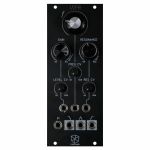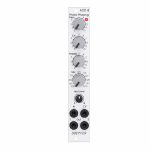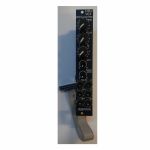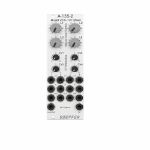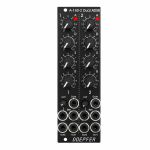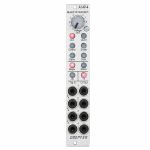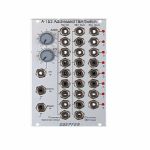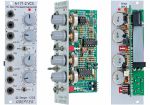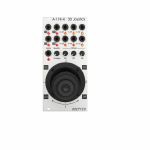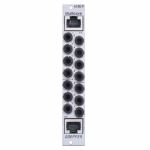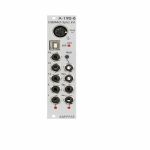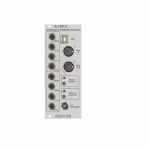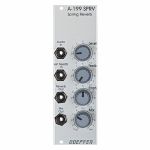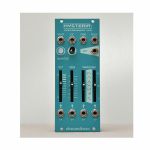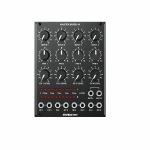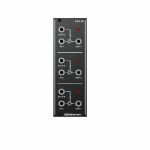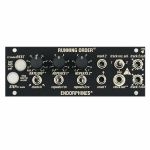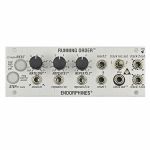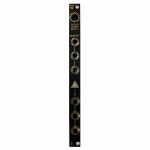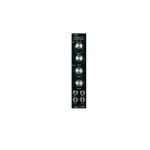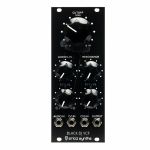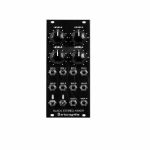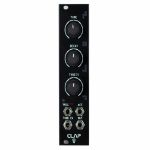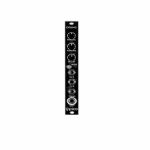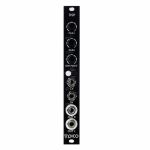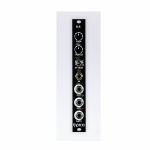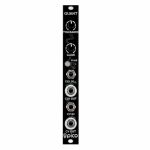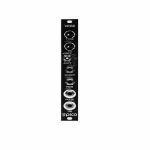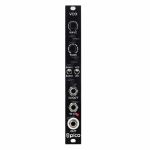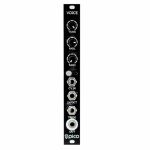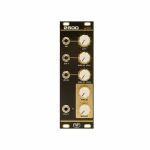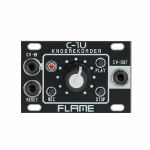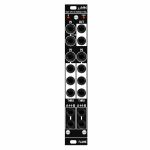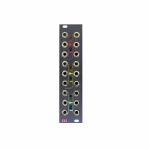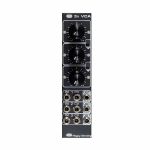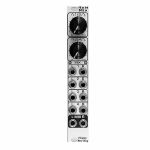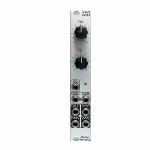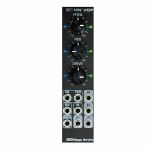Studio equipment
Our full range of studio equipment from all the leading equipment and software brands. Guaranteed fast delivery and low prices.
DJ equipment
Our full range of DJ equipment from all the leading equipment and software brands. Guaranteed fast delivery and low prices. Visit Juno DJ
Filter
Synth modules

The EnvGen8 chip was written/designed by Tom Wiltshire aka "Electric Druid".
1 ATTACK (1ms - 10s)
Sets the time, the Envelope takes to reach full level from the moment a gate is detected (Key is pressed)
2 DECAY (1ms - 10s)
Sets the time, after the envelope hits full level, to fade to the level set by the SUSTAIN Knob.
3 SUSTAIN (0% - 100%)
Sets the Volume to stay after the decay, while the GATE input is high.
4 RELEASE (1ms - 10s)
Sets the time for the fade out on falling edge of the GATE input (after the Key is released)
5 MODE switch
Select between exponential and linear curves.
6 PUNCH switch
Adds extra thump to very short percussive envelopes
7 LOOPING MODE switch
Allows selection between three different modes of operation. Gated mode is a normal envelope. Gated Looping will
trigger the ATTACK stage when the GATE goes high, then continue looping whilst the GATE remains high, and will
RELEASE to zero when the GATE goes low. The LFO Looping mode loops continuously and ignores input from the
GATE.
8 TIME (x1 - x100)
Overall Time control which shortens the length of the entire envelope.
9 TIME CV Attenuator
Attenuates incoming CV for Time modulation. Higher voltages will shorten the
length of the envelope.
10 TRIG Input
Re-trigger for the envelope. Useful for Polyphonic patches. Envelope goes to
ATTACK stage on rising edge of 0-5V pulse while Gate can still be on.
11 GATE Input
Normalized to TRIG Input. Envelope goes to RELEASE stage on the falling edge.
12 Level CV Input
Control the overall Volume of the envelope. Can be used for velocity control.
If nothing is plugged in, the Volume stays on max.
13 OUT
CV-output of the envelope (0 to +5V)
14 LED
Indicates the output voltage.
15 TIME CV
CV Input for Time modulation. Higher voltages will shorten the length of the
envelope.
16 INV. OUT
Inverted voltage of the output CV (0 to -5V)
Dimensions
10 HP
25 mm deep
Current Draw
16 mA +12V
16 mA -12V
7 mA 5V
This product is available for pre-order at Juno, for shipping on the release date. You won’t be charged until the order is despatched.
We'll keep you informed of your order at every stage, and let you know if the release date changes.
If the price of the item drops before it's released, you will pay the lower price, but if it increases, you'll only pay the price you see today.
If you also include in-stock items on your order, they’ll be charged and shipped within 24 hours as usual.You can select one of the two VCO cores of the engine to Produce Square Waves one and two octaves below the Oscillators frequency. You can blend between -1 and -2 octaves and Set the volume they are Mixed into the Main "Mix" output.
The knobs "VCO1" "VCO2" and "AM" set the level of the selected waveform of each VCO and the AM output from the Engine to the Main Mix. The "Ext In" Input is normalled from the RM output, but you can plug in any other signal to go to the Main Mix.
The V Ref sets a Voltage between 0V and +10V which compares against the Chaos signal from the engine (Chaos attenuator on the Engine doesn't matter). Whenever the Chaos signal is higher in Voltage than the Knob setting, It will Give you a Gate or Trigger signal depending on the switch. There is also a CV input, which offsets your V Ref and can create interesting Rhythms.
Features:
Two Sub-Octave generator with selection switch, Mix knob for -1 and -2 octaves (marked as /2 and /4)
5 Channel Audio Mixer for 4 different Outputs from the Engine and level for the Sub-Octave generator
External Input for Mixing with other signals
Semi-Random Gate or Trigger Output generated by the Chaos signal
Audio-optimized Chaos Output
Separate Outputs for Sub-Octave and Main Mix
Dimensions
8 HP
24 mm deep
Current Draw
6 mA +12V
5 mA -12V
This product is available for pre-order at Juno, for shipping on the release date. You won’t be charged until the order is despatched.
We'll keep you informed of your order at every stage, and let you know if the release date changes.
If the price of the item drops before it's released, you will pay the lower price, but if it increases, you'll only pay the price you see today.
If you also include in-stock items on your order, they’ll be charged and shipped within 24 hours as usual.The CubuSynth VCFA is a multimode VCF with LP,HP and BP modes with integrated VCA, CV control over Frequency, Resonance and Volume.
The CV input for the Frequency features 1V/Oct scaling over about 2~3 octaves. So you can even create plucky melodies
with the resonance in "ringing" mode.
The Gain control can reach a nice, soft saturation.
Key features
- 3 simultaneous outputs for Low Pass, Band Pass and High Pass
- Integrated VCA on input stage
- Input saturation on upper Gain levels
- CV control over Volume, Frequency and Resonance
- Frequency CV scalable for 1V/oct signals (stable up to 2-3 octaves)
- "ringing" appears on upper Resonance levels
Specifications
- Size: 10HP x 3U / 50mm x 129mm
- Depth: 34mm (measured from the front panel)
- Max. Current Draw:
+12V: +14mA
-12V: -14mA
This product is available for pre-order at Juno, for shipping on the release date. You won’t be charged until the order is despatched.
We'll keep you informed of your order at every stage, and let you know if the release date changes.
If the price of the item drops before it's released, you will pay the lower price, but if it increases, you'll only pay the price you see today.
If you also include in-stock items on your order, they’ll be charged and shipped within 24 hours as usual.The usual idea is that you put all your DROID controllers into a skiff case and mount your DROID master, X7 and G8 into another case, together with all your fancy Eurorack sound modules.
R2C is module 2 of a pair of two 2 HP modules that allow you to connect a chain of controllers to your DROID master through a standard 3.5 mm stereo cable (sometimes also called aux-cable).
The usual idea is that you put all your DROID controllers into a skiff case and mount your DROID master, X7 and G8 into another case, together with all your fancy Eurorack sound modules.
While you could do this with the typical 6-pin ribbon connector (e.g. the 80 cm version that we offer), using the R2M/R2C combination has some serious advantages:
The connection cable can be almost arbitrary long (20 m have been tested and works perfectly).
Since the connection is done on the front of the modules, you can quickly disconnect your skiff for the purpose of travelling to a gig.
You can use a standard 3.5 mm stereo TRS cable for the connection.
These modules are not just passive connectors but contain special driver ICs that transform the electronic voltage levels, which run in the 6-pin ribbon, to something more stable and reliable that is fit for longer distances in a more hostile environment.
The controllers do not receive their power from the master but from the R2C module, which has a power connector and a voltage regulator for that purpose. Each chain of the R2C module provides the same power to its controller chain as the master does (it contains the identical voltage regulator). That means that you can connect up to 32 controllers (!) to one R2C.
Another nice thing: The R2M/R2C combination allows for two of these master / controller connections in parallel. That means that you can have two masters being attached to their individual controller chains. That does not mean, that each of the masters can access each of the controllers at the same time, however. Both master / controller connections work completely separately.
Package contents:
* one R2M module
* one R2C module
* one Eurorack power cable for the R2C
* two 6-pin ribbon cables for connecting the R2M to two masters
* two 3.5 mm stereo TRS cables, approx.. 1.2 m
* 4 red M3 screws for mounting the two modules
quote 971155
This product is available for pre-order at Juno, for shipping on the release date. You won’t be charged until the order is despatched.
We'll keep you informed of your order at every stage, and let you know if the release date changes.
If the price of the item drops before it's released, you will pay the lower price, but if it increases, you'll only pay the price you see today.
If you also include in-stock items on your order, they’ll be charged and shipped within 24 hours as usual.The module has these controls and in/outputs available:
Control Man. : manual control of the phase shift offset (base value)
Control CV: attenuator for the signal applied to the CV socket
Control Feedb.: Feedback or Resonance (similar function as filter resonance/feedback/emphasis)
Control Mix: sets the mixing ratio between original and phase shift signal appearing at output 1
fully CCW: only the modified input signal appears at output 1 (see note below *)
center: a mixture between the modified input signal and the phase shift signal appears at output 1, that's the standard position for the classical phasing effect
fully CW: the pure phase shifted signal appears at output 1 (e.g. for vibrato effects)
Control Input Level: attenuator for signal applied to the In socket
Socket In: audio input
Socket CV: control voltage input
Socket Out 1: audio output 1 (mix signal)
Socket Out 2: audio output 2 (modified input signal)
LED: visual control of the phase shift
The module has some peculiarities (same as the historic model):
The input signal is processed at first by a pre-stage which outputs a "modified" input signal (*). This signal is not processed by the phase shift stages but is affected by the feedback setting. Only when feedback is set to zero this signal is identical to the input signal. Otherwise it contains feedback components.
This signal is output on socket Out 2.
When both output sockets Out 1 and Out 2 are used as stereo channels one obtains a spatial stereo sound effect.
The same signals is also used for the CCW position of the mix control. With mix control fully CCW the unmodified signal appears only if the feedback control is set to zero. Otherwise it contains feedback components.
The historic model had two audio inputs: one 5-pin DIN socket and a 1/4" jack socket. The DIN socket was intended for high-level line signals. When the 1/4" jack socket was used the amplification of the pre-stage increased by about 100. The 1/4" jack socket was intended for low level signals (e.g. electric guitars or microphones). For this feature the A-101-8 has an internal jumper that can be used to increase the amplification. As long as the module is used within the A-100 system usually the lower amplification is used to avoid distortion.
The 8 photo resistors and LEDs are assembled within an small lighproof box. In addition the pc boards are made of lighproof black material to avoid interfering light from other modules or the bus board.
Dimensions
4 HP
45 mm deep
Current Draw
30 mA +12V
30 mA -12V
quote 945411
It is the successor of the A-105 which had to be discontinued because the obsolete SSM2044 filter circuit. The A-105-2 is based on the SSI2144 which is in turn the successor circuit of the SSM2044. The features of both modules are nearly the same. The main difference is the clearly reduced front panel width of the A-105-2 (4HP instead of 8HP) and the associated changes of the controls and sockets positions. In addition the A-105-2 is equipped with 2 audio inputs.
The module has these controls and in/outputs available:
Control Frequ: manual frequency control
Control FCV2: attenuator for the frequency control voltage applied to socket FCV2
Control Q: manual resonance control
Control QCV: attenuator for the resonance control voltage applied to socket QCV
Control Input 1 Level: attenuator for the audio input signal applied to socket Input 1
Socket Input 1: audio input 1 (with attenuator)
Socket Input 2: audio input 2 (without attenuator)
Socket FCV1: frequency control voltage 1 (without attenuator, about 1V/oct scale)
Socket FCV2: frequency control voltage 2 (with attenuator)
Socket QCV: resonance control voltage (with attenuator)
Socket Out: audio output
Technical notes:
Frequency range: about 15Hz ... 15 kHz
Resonance up to self oscillation
Max. input voltage at Input 2 without clipping/distortion: about 15Vpp
Max. output voltage without clipping/distortion: about 15Vpp
The signals of both inputs are mixed before they are processed by the filter. This saves an external mixer for small setups.
Depth: 45 mm
HP : 4
It is the successor of the A-105 which had to be discontinued because the obsolete SSM2044 filter circuit. The A-105-2 is based on the SSI2144 which is in turn the successor circuit of the SSM2044. The features of both modules are nearly the same. The main difference is the clearly reduced front panel width of the A-105-2 (4HP instead of 8HP) and the associated changes of the controls and sockets positions. In addition the A-105-2 is equipped with 2 audio inputs.
The module has these controls and in/outputs available:
Control Frequ: manual frequency control
Control FCV2: attenuator for the frequency control voltage applied to socket FCV2
Control Q: manual resonance control
Control QCV: attenuator for the resonance control voltage applied to socket QCV
Control Input 1 Level: attenuator for the audio input signal applied to socket Input 1
Socket Input 1: audio input 1 (with attenuator)
Socket Input 2: audio input 2 (without attenuator)
Socket FCV1: frequency control voltage 1 (without attenuator, about 1V/oct scale)
Socket FCV2: frequency control voltage 2 (with attenuator)
Socket QCV: resonance control voltage (with attenuator)
Socket Out: audio output
Technical notes:
Frequency range: about 15Hz ... 15 kHz
Resonance up to self oscillation
Max. input voltage at Input 2 without clipping/distortion: about 15Vpp
Max. output voltage without clipping/distortion: about 15Vpp
The signals of both inputs are mixed before they are processed by the filter. This saves an external mixer for small setups.
Depth: 45 mm
HP : 4
quote 973745
Controls, In/Outputs and Functions of each VCA:
- Level (manual control of the VCA amplification), small rubberized knob (L1...L4)
- Control voltage input with associated attenuator (CV1...CV4), for the full VCA control range about 0...+5V control voltage are required (attenuator fully clockwise), for higher control voltages the attenuator is used, the attenuators are without knobs, just plastic shafts with white marker
- Signal Input
- Signal Output
- All inputs and outputs are DC coupled. Consequently the VCAs can be used to process both audio and control voltages (e.g. to control the level of LFOs or envelopes)
- The signal input is not equipped with an attenuator. But the VCAs can process all signals up to 15Vpp / -7.5...+7.5V without clipping. In case of higher levels an external attenuator is required (e.g. A-183-1).
- The available amplification range is 0...1, the maximal amplification is 1 (i.e. it "clips" and remains at 1 even if the control voltage goes beyond the value that corresponds to amplification 1)
Functions of the voltage controlled mixers:
- Two outputs ("Selected" and "All")
- Selected output: the ouput if a VCA is removed from this sum signal when a plug is inserted into the corresponding VCA output.
- All output: sum of all VCA outputs, regardless of inserted plugs into the VCA outputs
- The maximal amplification is about 0.6 to avoid clipping at the mixer outputs (otherwise the outputs may distort with 15Vpp signals at each signal input and full amplifications)
Special functions of the voltage controlled mixers (selectable by internal jumpers):
- Dual Stereo VCA: In this case the control unit of VCA1 (L1 + CV1) affects also VCA3 and the control unit of VCA2 (L2 + CV2) affects also VCA4, the control units of VCA2 and VCA4 are out of operation
- Quad VCA: In this case the control unit of VCA1 (L1 + CV1) affects all four VCAs. The control units of VCA2, VCA3 and VCA4 are out of operation. In this mode the module has the same function as module A-132-2. That's why module A-132-2 will be discontinued.
- Normalling of the signal inputs: by means of internal jumpers signal input 1 can be normalled to signal input 2, signal input 2 to signal input 3 and signal input 3 to signal input In 4. That way the same input signal can be distributed to four different channels by means of control voltages (e.g. quadrophonic distribution of audio signals). Suitable control voltage sources are e.g. A-144 (Morphing Controller) or A-143-9 (Quadrature LFO).
Each ADSR provides these controls and in/outputs:
- LED (displays the envelope output)
- A: manual Attack control
- D: manual Decay control
- S: manual Sustain control
- R: manual Release control
- Gate Input
- Retrigger Input
- CVT Input with attenuator (CVT = CV Time)
- Envelope Output 1
- Envelope Output 2
The output voltage range for each envelope is 0 - 10V. The time range of Attack/Decay/Release is about 1ms to 30s.
By means of internal jumpers one can select which time parameters are controlled by the CVT input (e.g. D only or D+R or A+D+R) and in which direction (i.e. if an increasing CVT shortens or stretches the time parameter in question).
Socket CVT can be normalled to an internal fixed voltage (i.e. the switching contact is connected to an internal fixed voltage). That way it's possible to change all time parameters simultaneously by means of the CVT control.
Another jumper is used to set output 2 to normal or inverted envelope.
And another jumper is used for the normalling of Gate 2 to Gate 1 (i.e. ADSR#2 is also triggered by Gate 1).
Two more jumpers are used for the optional bus access to the gate signal of the bus for each ADSR. Changing the positions of the mentioned jumpers allows to modify the factory settings.
Each ADSR provides these controls and in/outputs:
- LED (displays the envelope output)
- A: manual Attack control
- D: manual Decay control
- S: manual Sustain control
- R: manual Release control
- Gate Input
- Retrigger Input
- CVT Input with attenuator (CVT = CV Time)
- Envelope Output 1
- Envelope Output 2
The output voltage range for each envelope is 0 - 10V (10V = attack peak).
The time range of Attack/Decay/Release is about 1ms to 30s.
By means of internal jumpers one can select which time parameters are controlled by the CVT input (e.g. D only or D+R or A+D+R) and in which direction (i.e. if an increasing CVT shortens or stretches the time parameter in question).
Socket CVT can be normalled to an internal fixed voltage (i.e. the switching contact is connected to an internal fixed voltage). That way it's possible to change all time parameters simultaneously by means of the CVT control.
Another jumper is used to set output 2 to normal or inverted envelope.
And another jumper is used for the normalling of Gate 2 to Gate 1 (i.e. ADSR#2 is also triggered by Gate 1).
Two more jumpers are used for the optional bus access to the gate signal of the bus for each ADSR.
1 in stock $138.03
- VCLFO: voltage controlled low frequency oscillator
- VCA: voltage controlled amplifier, switchable to voltage controlled polarizer
- VC delay unit: voltage controlled linear attack envelope (only one parameter: attack) for delayed LFO operation in combination with the VCA (e.g. delayed vibrato/tremolo)
LFO: The voltage controlled LFO has the waveforms Triangle, Sine, Sawtooth and Rectangle available and features a Reset/Sync input. Triangle/Sine and Rectangle are displayed by means of dual-colour LEDs (probably red/green), Sawtooth has a unicolor LED available (probably blue). The output levels are about -4V...+4V for Triangle, Sine and Rectangle. The Sawtooth level is about 0...+8V.
The CV control can be switched to attenuator or polarizer ("CV Mode" switch). In polarizer mode the CV inputs affects the frequency in the reverse manner when the CV control is left from the centre position. In the centre position CV has no effect and right from the centre the control works like a normal attenuator. The frequency range (without external CV) is from about 0,005 Hz (i.e. about 3 minutes per period) to 200 Hz (with external CV max. frequency about 1kHz). In addition a ultra-low mode can be activated by means of an internal jumper. When the ultra-low jumper is set a fixed voltage is connected to the switching contact of the "LFO CV" socket. In polarizer mode of the CV control that way extremely low frequencies (up to one hour period and more) are possible. For this a jumper has to be installed on the pin header JP6. In the factory a dummy jumper is installed on the pin header JP7 "Dummy". JP7 has no function and is used only for "parking" of the jumper. Simply remove the jumper from JP7 and plug it on JP6. JP6 is located behind the CV control.
VCA: This is a linear VCA that can be switched to "normal" VCA (i.e. kind of a voltage controlled attenuator) or voltage controlled polarizer ("VCA Mode" switch). In the "normal" VCA mode amplification +1 is achieved with about +5V control voltage. In polarizer mode the amplification ranges from about -0.5 (i.e. inverted signal with about 50% level) with 0V CV to +0.5 (i.e. non-inverted signal with about 50% level) with +5V CV. With about +2.5V CV the signal is suppressed. Details about the functioning of a voltage controlled polarizer can be found in the description of the module A-133. In this mode the VCA can be treated also a DC coupled ring modulator (similar to A-114).
The VCA of the A-147-2 has three sockets available: "In" (signal input), "Out" (signal output) and "CV" (control voltage input).
The Triangle Output of the LFO is normalled to the VCA signal input by means of the switching contact of the "VCA In" socket. If another LFO waveform (or any other signal) should be processed by the VCA the corresponding signal has to be patched to the "VCA In" socket. The VCA can be used also independently from the LFO and the Delay CV. In this case the VCA sockets In, Out and CV have to be patched accordingly. The VCA can be used also as waveshaper for the LFO signals (e.g. by patching VCA In and VCA CV to different LFO signals, if necessary via attenuator A-183-1 or offset generator/attenuator A-183-2).
Attack/Delay: The third sub-unit of the module is a simple, voltage controlled envelope generator that has only the parameter "Delay" (or Attack) available. This unit generates a linear increasing voltage that starts from 0V after each Delay Reset until it reaches about +5V. Then the voltage remains at +5V until the next Delay Reset occurs. The inclination or gradient is controlled by the manual Delay control and the Delay control voltage ("Delay CV" input). The waveform is linear, the control scale is exponential. The output voltage is displayed by a green LED and available at the "Delay Out" socket.
The manual Delay control ranges - without external "Delay CV" - from about 5ms (fully CW) up to 2 minutes (fully CCW). By means of an external voltage applied to the "Delay CV" socket this range can be extended. A rising CV shortens the delay time (behaviour like a VCO)!
The Delay output voltage ranges from about 0V to +5V. The rising edge of the gate, clock or trigger signal applied to the "Delay Reset" sockets resets the Delay output voltage to 0 V.
"Delay Out" is normalled to the VCA CV input by means of the switching contact of the "VCA CV" socket and consequently controls the Triangle level provided that no other patch is made. A typical example is the usage of a Gate signal (e.g. from a USB/Midi-to-CV/Gate interface) as Delay Reset. That way a delayed vibrato or tremolo can be realized if the VCA output is patched to the frequency CV input of a VCO (or VCF), or the CV input of a VCA.
Manual controls for the criteria selection:
Octave range (manual control "Oct."): this parameter defines how many octaves are covered by the random voltages (0 ... +5V, with "Oct." control fully CCW only 0V are generated)
Grid (6 illuminated radio buttons): this parameter defines the grid of the random voltages:
Octaves (Oct)
Octaves + Quin (Quint)
Chords
Scale
Semitones
continuous (i.e. stepless)
Minor / Major (2 illuminated radio buttons): this parameter defines in case of chords or scales if they are minor or major. For all other grids this parameter has no meaning
Sixth / Seventh (2 illuminated separate buttons): these parameters defines if the sixth or seventh is added. Valid only if Oct, Quint, Chord or Scale is chosen as grid.
The output voltages follow the 1V/octave standard with exception of the Continuous mode. The voltages in this mode are totally random and do not follow the 1V/oct standard (i.e. not a multiple of 1/12V).
The generation of a new random voltage at the output (CV Out 1...4) is triggered by the corresponding trigger input (Trig. In 1...4). The trigger inputs are normalled top down. The minimum trigger level is +2.5V (up to max. +12V).
Applications:
random polyphonic structures (in combination with the polyphonic modules A-111-4, A-105-4, A-132-8, A-141-4 and e.g. A-157 as trigger source and A-173-1/2 for transposition of the polyphonic structures)
any application that requires several random voltages
Width: 4 HP / 20.0 mm
Depth: 45mm (measured from the rear side of the front panel)
2 in stock $141.98
Instead of voltage control even clock/reset controlled addressing of the active step is possible. The rising edge of each clock signal causes an advance to the next state. The rising edge of the reset signal resets to step 1.
The sum of the voltages coming from the manual Address control and the CV input define the currently addressed step of the 3 sub-devices. If the module is controlled by clock and reset the control voltage has to remain unchanged as the CV control has priority over the clock/reset control (e.g. simply turn the CV control fully counter-clockwise and do not touch the Address control knob).
Sub-device #1 is the bidirectional 8-fold multiplexer (kind of an electronical 8-fold rotary switch). Bidirectional means that it works into both directions like a mechanical rotary switch: the common socket may work as an output that is connected to one of the 8 inputs that are e.g. connected to modulation or audio sources. But the common socket may even function as input. In this case the signal applied to the common socket is output to the currently addressed single socket. The voltage range of the in/outputs to be switched is the full A-100 voltage range -12V....+12V. All A-100 signals can be switched without any restrictions.
Sub-device #2 is the addressed 8-fold T&H. The signal at the common T&H input is connected to the addressed T&H output. As soon as a new output is addressed the last voltage is stored at the output (Track&Hold function). The T&H section of the A-152 allows the emulation of the "toggling T&H" function of the Buchla module 266 "Source of Uncertainty". Only the first two T&H outputs of the A-152 are required for this application. This unit can be used also as kind of an analogue (shift) register. The difference to a "real" analogue shift register is that the sampled output voltages are not shifted to the next output but remain allocated to the same output. But in some cases (e.g. controlling the pitch of 3 VCOs by 3 output voltages of the A-152) the result is the same.
Sub-device #3 is the digital output section. The digital output of the currently addressed turns to "high". All other digital outputs are low. The digital outputs can be used to trigger e.g. envelope generators or to control the reset input in the clocked mode to reduce the number of addressed stages.
The Clock input will take any digital signal from, eg., an LFO, MIDI sync, or the gate from a MIDI-CV interface. At the outputs, you have access to three sets of seven different sub-divided clock signals, from half the clock frequency down to 1/128. The low/high levels of the output signals are 0V and about +10V.
The A-160-2V also has a reset input. Whenever a reset signal is sensed, all outputs are set to certain levels which depend upon the selected mode.
HP : 4
quote 864696
A manual control is used to adjust the clock multiplication factor manually without the need of an external control voltage. The voltage generated by this control ("Manual") is normalled to the CV In socket. As long as no plug is inserted into the CV In socket the clock multiplication factor is adjusted by means of the manual control knob and displayed by the LEDs. For dynamic applications (like the ratcheting function described below) the manually generated CV is overwritten by the external CV which has to be fed into the CV In socket.
The module can be used for all kind of clock multiplying applications. One important example is the generation of so-called ratcheting sequences. The band Tangerine Dream is famous for this kind of sequences. A normal sequencer generates only one gate signal per step. A ratcheting sequence may have also more than one gate pulses per step. This function can be obtained by using the A-160-5: one CV output of the sequencer is used to define the number of gate pulses per step. If the control of the step in question is fully CCW the generated CV is 0V and no gate signal is generated (mute of the step). When the control of the step in question is turned clockwise one, two or more gate pulses are generated depending upon the position of the mode switch and the voltage generated by the CV at this step.
Technical note: Due to the nature of clock multiplying it takes a few input clock pulses until the clock output is stable. One has to average a few input clock pulses to generate the multiplied clock output signal. Even when the input clock frequency changes it will take a few cycles until the output clock signal is correct as the module cannot foresee the future of the clock input signal. The generated clock output signal is derived from the last few cycles of the clock input signal. Consequently the module should be driven only by a clock signal with constant or slowly changing frequency.
quote 745789
Typical applications:
- VC Slew Limiter / VC Portamento / VC Low Pass Gate:
Cycle switch = off, no trigger signal applied to Trig socket: Voltage controlled Slew limiter or portamento generator: the signal applied to the signal input is "slewed". The slew up and down times are controlled manually by means of the Up and Down controls, the effect of the CV Up and CV Down control voltages are controlled by the CV Up and CV Down controls, in exponential mode these controls also affect the slew shape (see symbols at the CCW and CW positions of the controls).
If an audio signal is applied an short slew rates are chosen the module works as a simple VCF/VCA combo.
- A/D Envelope Generator / Pulse Delay / Subharmonic Generator:
Cycle switch = off, trigger signal applied to Trig socket, no input signal: Simple Attack/Decay envelope Generator, the rise and fall times are controlled like the slew up/down times above, including the shape of the falling/rising slope of the envelope, the exp. CV input can be used to change both attack and decay simultaneously.
At the End output a pulse appears as the end of the envelope is reached (less than about 20mV), this can be used as a pulse delay.
If a series of triggers are applied to the VCS faster than the total rise and fall times, the module will divide the incoming signal by a whole number. In the audio range the output will be the sub-harmonic series.
- VCLFO / VCO:
Cycle switch = on, no trigger signal applied to Trig socket, no input signal: Voltage controlled LFO/VCO, the rise and fall times of the waveform are controlled like the slew up/down times above, including the shape of the falling/rising slope
the exp. CV input can be used like the CV input of a VCO or VCLFO, the response is exponential but not exactly 1V/oct.
quote 577809
For each control voltage the non-inverted signal (X, Y, Z) as well as the inverted signal with adjustable offset (-X+XO, -Y+YO, -Z+ZO) are available. The generic joystick control voltages are bipolar, i.e. they range from typ. -5V (lowest position) via 0V (center position) to typ. +5V (highest position). The "Overlap" switches can be used to add a fixed offset voltage of typ. +5V to the non-inverting output in question so that the output voltage range changes to typ. 0...+10V (rather than -5...+5V). That's necessary if e.g. a VCA has to be controlled, which requires a pure positive control voltage range. The switches are named "overlap" because they allow the overlapping of the non-inverting CV output (X, Y, Z) with the inverting output (-X+XO, -Y+YO, -Z+ZO) for crossfading applications. With the overlap switch "on" and appropriate setting of the offset control it's possible to obtain a control voltage range of 0...+10V for the non-inverting output and +10V...0V (i.e. same range but opposite direction) for the inverting output.
The offset voltages which are added to the inverting outputs can be adjusted by means of three small potentiometers. That way different kinds of control voltage ranges are possible, e.g.
-5V ... +5V for the non-inverting output and +5V ... -5V for the inverting output ( Overlap = off, Offset = 0)
0 ... +10V for the non-inverting output and +10V ... 0V for the inverting output ( Overlap = on, Offset = max)
-5V ... +5V for the non-inverting output and +10V ... 0V for the inverting output ( Overlap = off, Offset = max)
0 ... +10V for the non-inverting output and +5V ... -5V for the inverting output ( Overlap = on, Offset = 0)
On top of this the four quadrant voltages Q1, Q2, Q3 and Q4 are available. A quadrant voltage becomes positive when the joystick is positioned in the quadrant in question.
Each CV output is equipped with an LED that displays the present voltage.
Because of the construction height of the joystick (about 7 cm) the module cannot be installed into the cases A-100P6, A-100P9, A-100PMS6, A-100PMS9 and A-100PMS12 during transportation as the depth of the case cover is not sufficient. Into the base cases A-100PB and A-100PMB as well as in all other cases without cover the module can be installed without problems.
HP : 12
1 in stock $149.07
The upper network connector is wired to the eight sockets 1-8, the lower to the six sockets A-F. That way it's possible to pre-patch different cases and connect signals, that are required in all cases (e.g. clock, start/stop, master CV) by means of one or two cables only instead of 14 individual patch cables. When only eight signals are required only the upper network connector is required and the sockets 1-8 are used. When more than eight signals have to be patched both network connectors have to be used. It's also possible to wire the upper and lower network to different cases (i.e. signals 1-8 to external case #1 and signals A-F to external case#2).
The module is fully passive (no power supply required) and simply wires the 14 sockets to 14 pins of the network connectors.
The A-180-9 comes in pairs for combining two modular systems.
quote 755412
- Gate Input (min. +5V)
- CVN Input (defines the Midi note number), 1V/octave standard, range 0...+10V (i.e. 10 octaves)
- CVV Input (defines the velocity value assigned to the Midi note message), can be used alternatively for Midi volume (CC#7), range 0...+5V
- CVC Input (free assignable to any Midi control change number), range 0...+5V
For both sub-units a common CV Transpose input is available (1V/octave, range 0...+10V). The voltage applied to this input is added internally to CVN before the Midi note number is generated. It can be used e.g. to transpose two sequences simultaneously by one voltage.
How it works:
Whenever the rising edge of the Gate input is recognized a Midi note on message is generated. The note number corresponds to the sum of the voltages applied to the CVN input and the common CV Transpose Input that is present at the rising edge of the gate signal.
quote 755414
The 3-spring system used in the A-199 ensures a "dense" reverb because of the different properties of the three springs.
The A-199 implies some special features that are not self-evident for spring reverb units:
The reverb signal can be fed back to the input using the Feedback control. Even self-oscillation of the springs similar to the self-oscillation of filters is available. The feedback loop can lead even via external modules like VCA, VCF, phaser, frequency shifter, vocoder, distortion/waveshaper, ring modulator and others. In this case the reverb output of the A-199 is connected to the input of the external module(s) and the output of the external module(s) is fed back to the Ext. Feedback In socket of the A-199. This socket contains a switch that interrupts the internal feedback loop as soon as a plug is inserted.
Another feature is the Emphasis control. This enables the adjustment of the accentuation of middle frequencies (around ~ 2kHz).
With the Mix control the relation between original and reverb signal appearing at the mix output is adjusted.
Using all these features very extreme and unusual effects can be generated with the A-199.
The sounds themselves rest on a variable waveform selector - meaning you can scroll through the waveforms and blend them together. This can even be CV controlled, so you can obtain an evolving sound that changes over time. The modules in the Chromatic series give you a great starting point in the world of modular synths and are a must-have for beginners and professionals alike.
Power Consumption: 114mA @ +12V , 46mA @ -12V
10HP
35 mm deep
2 in stock $111.43
50mm deep
1 in stock $123.71
1 in stock $110.43
quote 774896
Zero-jitter clock generation: less than 50 microseconds internal clock jitter
101 style 1/16th note input mode (step/rest) with manual or CV controllable amount of triggers repeats when the active trigger step happens
Euclidean mode enabled for each track where we set Euclidean total steps amount in the circle and then amount of triggers happening in that circle.
Per step trigger probability in 101 mode and global probability in Euclidean mode.
Separate synchronization (reset) inputs, sync for track 1 is normalled to sync track 2
Clock divider for incoming external clock allows to quickly obtain various musical divisions on the fly incl. triplets of course, but more importantly tuplets mode allows you to stretch desired amount of triggers happening into a single bar
Separate mute buttons for each track
8 patterns of triggers sequences stored in the module and recalled on the next power up
Available in 3U / 6HP version
Power consumption:
30 mA +12V
10 mA -12V
0 mA 5V
Dimensions
22 HP
26mm deep with power ribbon cable connected
2 in stock $133.88
Zero-jitter clock generation: less than 50 microseconds internal clock jitter
101 style 1/16th note input mode (step/rest) with manual or CV controllable amount of triggers repeats when the active trigger step happens
Euclidean mode enabled for each track where we set Euclidean total steps amount in the circle and then amount of triggers happening in that circle.
Per step trigger probability in 101 mode and global probability in Euclidean mode.
Separate synchronization (reset) inputs, sync for track 1 is normalled to sync track 2
Clock divider for incoming external clock allows to quickly obtain various musical divisions on the fly incl. triplets of course, but more importantly tuplets mode allows you to stretch desired amount of triggers happening into a single bar
Separate mute buttons for each track
8 patterns of triggers sequences stored in the module and recalled on the next power up
Available in 3U / 6HP version
Power consumption:
30 mA +12V
10 mA -12V
0 mA 5V
Dimensions:
22 HP
26mm deep with power ribbon cable connected
1 in stock $142.60
quote 734891
Speed : speed of the LFO, range from 0.1 Hz to +/-200 Hz
Wave (LFO 1 & 2) : 16 Syncable waveforms
The ZONE B.F. (black edition onwards) now features an additional mode. On the back of the PCB you will find two jumpers, marked as JP1. CV1 is LFO channel 1 and CV2 is LFO channel 2. By moving the jumper so it sits on one leg (rather than 2 as when you have received the module), the Sync input for either LFO channel now becomes LFO speed input, controllable via CV.
Tech Specs
- SYNC 1 & 2 : LFO waveform is reset when an impulse signal is received
- OUT 1 & 2 : LFO signal outputs 1 & 2
- Voltage swing is -/+5V
- LEDs display LFO activity
- Eurorack 5 HP
- Metal pot, panel mounted, screwed
- Consumption: +12V 40mA, -12V 10mA
Supplier's Notes:
As its name suggests, the Erica Synths Black DJ VCF provides sound treatment functionality typically found on DJ decks - it is fully open when the cutoff knob is set to 12:00. When turned counter-clockwise, lowpass filtering is applied and when turned clockwise, highpass filtering is applied. The filter also has a nice-sounding resonance parameter. This module provides hands-on control over the sound during the performance, as well as unconventional timbre modulations that are hard to achieve with conventional state variable filters. The Black DJ VCF is a fully analogue design and consists of two VCFs - highpass and lowpass in series and the filter management is done by complex CV routing.
CUTOFF
This is the main control of the module - manual cutoff frequency adjustment with a twist - it's fully open when the cutoff knob is set to 12:00. When turned counter-clockwise, lowpass filtering is applied and when turned clockwise, highpass filtering is initiated
AUDIO LVL
Adjust the audio signal level
RESONANCE
Adjust the resonance level manually. On settings over 1PM, the filter will start to self-oscillate. The resonance is incoming audio signal-sensitive - a signal of greater amplitude may reduce the impact of resonance on the resulting sound
CV1 LVL
This is the cuto CV attenuverter. Adjust the CV level to your taste! Notice that the cutoff CV works differently compared to conventional state variable filters - it sweeps the filter from closed lowpass through fully open to closed highpass
CV2 LVL
This is another cuto CV attenuator
CV2 IN
This is the cuto CV2 input, which is controlled by the attenuator knob
AUDIO IN
Patch your audio signal here.
OUTPUT
This is the audio output of the module.
CV1 IN
This is the cutoff CV1 input. The CV1 level is adjustable by the CV1 LEVEL attenuverter knob.
Features
Fully analogue DJ-style VCF
Manual resonance control
Cuto ff CV attenuverter and attenuator
Input and output
Protection against undesired overvoltage
Technical specifications:
Audio level: 10Vptp
CV level : -10V - +10V
Filter slope: 24dB/oct
Power consumption: +55mA, -58mA
Module width: 10HP
Module depth: 35mm
2 in stock $118.43
In order to save rack space, we designed a compact mixer with a lot of cool, performance oriented features.
Check out also the Black Pre-fade Listen Expander that is a satellite module to Erica Synths Black Stereo Mixer!
Erica Black series are high-end modules with unique functionality. Only the highest quality components are used and all inputs and outputs are protected against undesired overvoltage. When designing the Black Series, we did not economise on the module width, we put design and usability first. Big knobs are assigned to functions that make difference in sound. Together the Erica Black series are a range of modules that make an entire synthesizer.
quote 716534
Features
Tone and Decay controls
CV control with an attenuator over Tone
Manual trigger
Accent for Better expression
Decay range: 120ms - 1100ms
Audio output level: -5...+5V
CV level (full span): -5 - +5V
Trigger level: 5V
Trigger time: 1ms
Accent CV level: 10V
Power consumption: 24mA@+12V, 20mA@-12V
Module width: 6HP
Module depth: 35mm
On this run of modules the Pitch & Decay CV inputs are inverted: rising CV will decrease pitch, falling - increase.
quote 690940
Technical specifications:
Output level: 10Vptp
CV level (full span): -5V - +5V
Power consumption: +28mA, -5mA
Module width: 3HP
Module depth: 35mm
quote 732840
quote 686670
Technical specifications:
Preamp boost: up to +40dB
Audio output level: 10Vptp
Envelope output level: 0 - +10V
Gate level: +5V
Power consumption: 25mA, -15mA
Module width: 3HP
Module depth: 35mm
quote 809147
- 8 preset scales
- Web based interface for user generated and extra preset scales
- Microtonal quarter tone scales
- Adjustable tolerance
- Adjustable CV glide between notes
- Clocked and independent quantization
Dimensions
3 HP
35 mm deep
Current Draw
25 mA +12V
6 mA -12V
quote 686628
Features:
Manual TUNE and PWM controls
+-1 octave switch
1V/oct input with good tracking across 8 octaves
PWM CV input
Pulse and triangle waveform outputs
Input protection against overvoltage
Protection against reverse PSU connection
Technical specification:
Output signal amplitude: -5V - +5
PWM CV input (full span): -5V - +5V
Power consumption: +21mA, -19mA
Module width: 3HP
Module depth: 35mm
quote 732841
Features
2 banks, 16 waves each
VCO/LFO mode
Voltage controlled wavesurfing
Wave morphing in LFO setting
Typically you would need several rather expensive modules to generate similar sounds, besides there's an extra feature: flip a switch, and you have a versatile LFO.
With Pico Series we challenged ourselves - can we make ANY superior functionality synth module 3HP wide and affordable? Yes, we can.
Technical specification:
VCO frequency range: 30Hz - 5kHz
LFO frequency range: 0,1Hz - 20Hz
1V/Oct input signal amplitude: 0V - +10V;
Output amplitude: 10V ptp
Power consumption: +26 mA, -4 mA
Module width: 3HP
Module depth: 35 mm
quote 686634
Dimensions
3 HP
35 mm deep
Current Draw
30 mA +12V
20 mA -12V
quote 686678
This product is available for pre-order at Juno, for shipping on the release date. You won’t be charged until the order is despatched.
We'll keep you informed of your order at every stage, and let you know if the release date changes.
If the price of the item drops before it's released, you will pay the lower price, but if it increases, you'll only pay the price you see today.
If you also include in-stock items on your order, they’ll be charged and shipped within 24 hours as usual.It has an audio inputs, two CV ins and an audio out.
You can control audio input level, CV levels, frequency cutoff and resonance.
It has a beautiful sound and it can go from relatively clean to dirty and screamy depending on audio signal level and resonance.
Tech specs:
- 8HP width
- 35mm depth behind front panel including the power connector
- standard 10 pin euro power +12V / -12V
- power consumption +12V 7mA , -12V 13mA
quote 972051
The track can be played once only (one shot) or in loop. The speed of the play back or the output offset is controllable with the pot. There are an additional CV input for CV recordings and a reset input.
The track data remains permanently stored when a 3V battery is used to buffer the RAM. When the module is switched on, the recorded data is available again. The module can be operated unipolar or bipolar (set by jumper on the back).
Note: The C-1U KnobRekorder uses a standard 3v lithium backup battery , type CR2032. The battery is needed to keep recordings and settings stored when the Eurorack case is turned off.
Dimensions: 12 HP
Power consumption: 20mA at +12 V and 9mA at -12 V
Module is a 1U tile.
quote 880300
At the heart of the two-input MIDI merger is a small, powerful ARM processor with plenty of buffer memory. Two MIDI streams are mixed to one output and can also be tapped via an additional second output. Two LEDs signal the operation of the merger: one LED indicates MIDI activity at the inputs, and a second LED warns of too much data at the inputs.
The second group of functions consists of two independent, separate MIDI THRU distributors. The MIDI data at the respective MIDI input can be picked up and distributed at the three THRU outputs. If required, a 1-to-5 distributor can be created from the two units by connecting an output of the left group to the input of the right group.
Features:
4x MIDI IN (TRS-B)
2x MIDI-OUT (TRS-B)
6x MIDI-THRU (TRS-B)
Powered via Doepfer connector
quote 990518
It is composed of three identical sections, the red, yellow and green, each of those featuring three inputs summing amplifier with three independently buffered outputs.
Derived directly from the CGM creative mixer series, the sum section is DC coupled, allowing the sum of control voltages as well as audio signals.
With an extremely low tolerance in both sum and output sections, it is suitable also for summing quantized voltages like the ones coming out from the quantized outputs of the SAPEL.
In case CVs or audio signals are particularly hot, the 6dB attenuator might be helpful to reduce exactly by 50% the incoming signals.
Red and yellow output are also normalled to the 1st jack socket of the yellow and green input: in this way this module can also work as a 1 to 9 buffered multiple.
quote 673007
Using the Time knob, Shapes can cycle from as low as 8 seconds (whale song) to as high as 19500Hz (bat beeps).
Shapes has 3 simultaneous outputs:
sawtooth (+/-5V, 10Vpp)
ramp (+/-5V, 10Vpp)
triangle (+/-5V, 10Vpp)
Additional waveforms may be derived courtesy of the Shape knob. Anticlockwise from 0 achieves progressively logarithmic sawtooths and ramps, whereas clockwise from 0 achieves progressively exponential sawtooths and ramps. The effect of the Shape knob on the triangle waveform is asymmetric, anticlockwise from 0 achieves progressively logarithmic leading edge, whereas clockwise from 0 achieves progressively exponential falling edge. Progressively exponential triangle waveforms can be achieved using the Time CV knob (set Shape knob to 0) providing there is no jack in the Time CV input socket
Time CV input provides wide ranging control of time. It is possible to dial in something approaching 1V/oct over a limited range, although Shapes has not been designed to perform as an accurately tracking VCO. In the audio range, Shapes comes into its own when used as a 'daughter' VCO to an external 'mother' VCO by patching the 'mother' VCO into Shapes' Gate In input socket - some impressive oscillator sync style effects can be achieved.
Gate In can also be used to initiate waveforms in one-shot mode, where a pulse of any length will cause Shapes to complete one cycle.
*Shapes has not been designed to perform as an accurately tracking audio VCO.
Product Specifications
12V draw: 15mA
5V draw: 0mA
-12V draw: 15mA
Depth: 45mm
Width: 4HP
2 in stock $113.33
quote 936230
60 mA +12V
60 mA -12V
35 mm Depth
2 in stock $103.07
Supplier's Notes:
4xSt.Mixer is 4 HP quad stereo mixer.
Right inputs are normalled to Left inputs for easy mono operation
Several 4xSt.Mixers can be chained together or with other HN stereo modules via sockets on the back side
65 mA +12V
50 mA -12V
35 mm deep
quote 819288
Upper inputs (section 1) are normalled to lower inputs (section 2). Thus the same signal pair A&B can be differently crossfaded in both sections.
The switch clones section's 1 controls to the section 2, which is useful to make stereo Dry/Wet adjustment or stereo VCA.
This module can be used as:
two independent crossfades
two independent VCAs
stereo crossfade or Dry/Wet control
stereo VCA
panner
Four jumpers on the back can give optional 5x amplification for each A or B input. Sot it is easy to crossfade modular level with linear level from pedals. Installed jumpers give 1x amplification, removing jumpers gives 5x amplification.
Output 1 is mixed with output 2 if left unconnected.
quote 805965
Supplier's Notes:
FM AID is a module designed to perform through-zero linear Frequency Modulation (FM) in the analog modular world. Any arbitrary signals can be used as a Carrier and Modulator. The module copies FM in how it is done in digital implementation, but in a completely analog circuit free of digital aliasing artifacts. Digital or software FM oscillators are mainly based on a ramp waveform which is then shaped to other waveforms. This is also represented in the FM AID module: sawtooth signal is expected on the Carrier input to give the indicated sine, triangle, sawtooth and square waveforms on the respective outputs. However the user is not limited to only use sawtooth for the Carrier and any other signal can be plugged giving many complex waveforms at the outputs.
All known FM tricks from digital implementation are also applied - you can endlessly experiment with the Carrier/Modulator frequency ratios, Modulation index (FM knob), Modulator's amplitude shaping (CV knob), feedback FM (output is fed back to the Modulator's input) and many other.
Carrier input has normalled connection to the Modulator's input. This internal routing is disconnected each time a plug is inserted in the Modulator's input. That is a handy option which allows the module to be used with only one signal source - this single signal will act as Carrier and Modulator at the same time. There won't be any frequency differences between Carrier and Modulator in this case, but many interesting wave folding sounds will be available anyway.
Technically speaking FM AID uses Phase Modulation, not Frequency Modulation. The sonic difference is that the produces sound is brighter.
SPECIFICATIONS
Carrier input level: -5V ... + 5V (can also accept inputs ranging from -1V ... +1V] to [-12V ...+12V] / [-15V ...+15V] using onboard trimmer)
Modulator input level: preferably -5V ... + 5V
CV input level: preferably -5V ... + 5V
outputs level: -5V ... + 5V
outputs impedance: 1 kOhm
module depth: 3 cm or 1,5 inches
power consumption: +45 /-45 mA at +/-12 Vdc, +50 /-50 mA at +/-15 Vdc
1 in stock $122.46
The possibility to have CV over "Resonance" and "Drives" makes it a very capable 6 HP filter.
"LP!" output has 6 dB steeper slope (18 dB) compared to ordinary 12 dB "LP" output. Plus it has much more drive.
Dimensions
6 HP
35 mm deep
Current Draw
55 mA +12V
65 mA -12V
quote 960500




